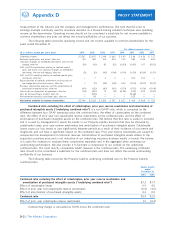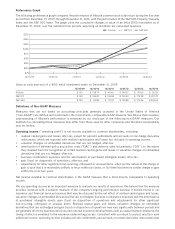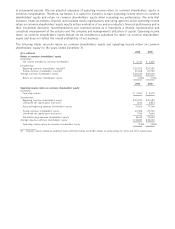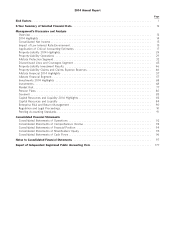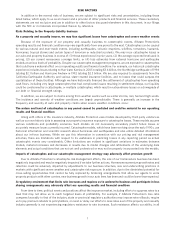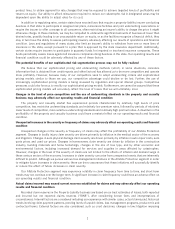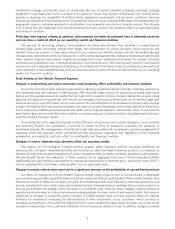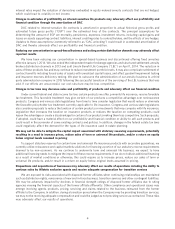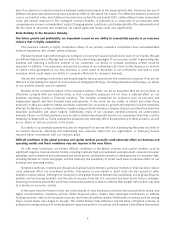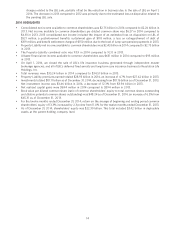Allstate 2014 Annual Report Download - page 104
Download and view the complete annual report
Please find page 104 of the 2014 Allstate annual report below. You can navigate through the pages in the report by either clicking on the pages listed below, or by using the keyword search tool below to find specific information within the annual report.interest rates impact the valuation of derivatives embedded in equity-indexed annuity contracts that are not hedged,
which could lead to volatility in net income.
Changes in estimates of profitability on interest-sensitive life products may adversely affect our profitability and
financial condition through the amortization of DAC
DAC related to interest-sensitive life contracts is amortized in proportion to actual historical gross profits and
estimated future gross profits (‘‘EGP’’) over the estimated lives of the contracts. The principal assumptions for
determining the amount of EGP are mortality, persistency, expenses, investment returns, including capital gains and
losses on assets supporting contract liabilities, interest crediting rates to contractholders, and the effects of any hedges.
Updates to these assumptions (commonly referred to as ‘‘DAC unlocking’’) could result in accelerated amortization of
DAC and thereby adversely affect our profitability and financial condition.
Reducing our concentration in spread-based business and exiting certain distribution channels may adversely affect
reported results
We have been reducing our concentration in spread-based business and discontinued offering fixed annuities
effective January 1, 2014. We also exited the independent master brokerage agencies and structured settlement annuity
brokers distribution channels in 2013 and sold Lincoln Benefit Life Company (‘‘LBL’’) on April 1, 2014. The reduction in
sales of these products has and may continue to reduce investment portfolio levels. It may also complicate settlement of
contract benefits including forced sales of assets with unrealized capital losses, and affect goodwill impairment testing
and insurance reserves deficiency testing. We plan to outsource the administration of our annuity business to a third
party administration company in 2015 following the successful transition of the servicing of the LBL business that was
sold. If our efforts are unsuccessful, our cost structure may be less competitive.
Changes in tax laws may decrease sales and profitability of products and adversely affect our financial condition
Under current federal and state income tax law, certain products we offer, primarily life insurance, receive favorable
tax treatment. This favorable treatment may give certain of our products a competitive advantage over noninsurance
products. Congress and various state legislatures from time to time consider legislation that would reduce or eliminate
the favorable policyholder tax treatment currently applicable to life insurance. Congress and various state legislatures
also consider proposals to reduce the taxation of certain products or investments that may compete with life insurance.
Legislation that increases the taxation on insurance products or reduces the taxation on competing products could
lessen the advantage or create a disadvantage for certain of our products making them less competitive. Such proposals,
if adopted, could have a material effect on our profitability and financial condition or ability to sell such products and
could result in the surrender of some existing contracts and policies. In addition, changes in the federal estate tax laws
could negatively affect the demand for the types of life insurance used in estate planning.
We may not be able to mitigate the capital impact associated with statutory reserving requirements, potentially
resulting in a need to increase prices, reduce sales of term or universal life products, and/or a return on equity
below original levels assumed in pricing
To support statutory reserves for certain term and universal life insurance products with secondary guarantees, we
currently utilize reinsurance and capital markets solutions for financing a portion of our statutory reserve requirements
deemed to be non-economic. As we continue to underwrite term and universal life business, we expect to have
additional financing needs to mitigate the impact of these reserve requirements. If we do not obtain additional financing
as a result of market conditions or otherwise, this could require us to increase prices, reduce our sales of term or
universal life products, and/or result in a return on equity below original levels assumed in pricing.
Dispositions and acquisitions of businesses may adversely affect our results of operations including the ability to
continue sales by Allstate exclusive agents and receive adequate compensation for transition services
We are exposed to risks associated with disposed former affiliates when continuing relationships are maintained
such as distribution rights, reinsurance of new and in-force business, transition services and other contingent liabilities.
We may be adversely impacted by declines in financial strength ratings of disposed former affiliates due to rating
agencies viewing the financial capacity of the former affiliate differently. Other compliance and operational issues may
emerge involving agents, products, pricing, servicing and claims related to the business reinsured from the former
affiliate to the Company. In addition, during a transition period when the Company may be providing transition services,
we may not be receiving adequate compensation and could be judged as not providing service as contracted. These risks
may adversely affect our results of operations.
4


